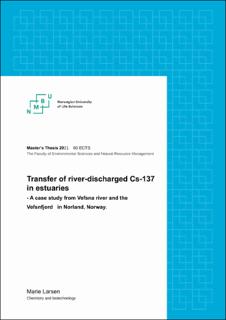| dc.description.abstract | Several decades after the Chernobyl accident, it is still detectable activities of Cs-137 in the environment. Norway was highly affected by radioactive fallout, where one of the locations that received the highest doses of Cs-137 was Nordland county. Recent studies have shown that the Vefsnfjord is amongst the fjords in Norway with highest activity of Cs-137. The Vefsna river feeds into the Vefsnfjord, creating an estuarine environment with a brackish surface layer, and an increasing salinity gradient outward the fjord. In this work, Cs-137 in the estuarine environment has been studied in water, sediments, and biota to identify changes in speciation, mobility, and bioavailability of Cs-137 outward the Vefsnfjord with increased salinity and distance to the river outlet.
The activity concentration of Cs-137 in water decreased as the salinity increased, from 4.0 ± 0.6 Bq/m3 to 3.0 ± 0.2 Bq/m3. By performing in situ fractionation of water and measuring activity of Cs-137 using HPGe-detector, it was reviled that the dominating specie was LMM in both freshwater and seawater, with low activity concentration of colloids (<0.86 ± 0.14 Bq/m3) and particles (0.55 ± 0.087 Bq/m3) in freshwater. Cs-137 associated with river discharged colloids and particles was only identified in the lowest salinity in the estuary (5 PSU) and was lower than estimated by dilution. On the contrary, activity concentration of LMM species was slightly increased in low salinity seawater compared with the riverine water and, and higher than estimated by dilution, likely caused by remobilization from river transported colloids and particles.
Grain size analysis of surface sediments showed that the riverine sediments mostly consisted of sand (>90%), while silt (45-86%) was the dominating size fraction in marine sediments. The content of clay was generally low (0.03-2%). The mineral structure was established by performing XRD analysis, where the silt samples consisted mostly of quartz and albite, while clay contained muscovite. The activity concentration of Cs-137 in sediments increased with increased distance outwards the fjord (from 35 ± 1.5 Bq/kg to 152 ± 6.0 Bq/kg), which can be explained by reduced content of sand, while the content of silt increased. Results show that the activity concentration of Cs-137 in sand was low (<66 ± 7.3 Bq/kg), while the activity concentration of Cs-137 in silt was higher, especially in the riverine sediments (529 ± 16 Bq/kg). However, the highest activity concentration of Cs-137 was found in riverine clay (3631 ± 28 Bq/kg). While it was no significant change activity concentration of Cs-137 in sand from
marine sediments compared to riverine sediments, a significant reduction in activity concentration was observed for silt and clay.
Sequential extraction of silt and clay from riverine- and marine sediments showed that Cs-137 was irreversibly bound to both silt and clay, as 42-58% of Cs-137 was extracted with 7 M nitric acid, while the remaining Cs-137 was left in the residue. Cs-137 bound to silt showed somewhat higher mobility than Cs-137 bound to clay, but it was no significant difference in mobility between riverine sediments and marine sediments. Apparent Kd values for Cs-137 showed an increasing trend for sediments (total) with increased distance out the fjord from (7.4± 0.99) ·103 L/kg to (2.6± 0.26) ·104 L/kg. The Kd was high for silt ((1.1 ± 0.15)·105 L/kg) and clay ((5.5 ± 0.74) ·105 L/kg) from riverine sediments, but a significant decrease in Kd was observed for silt and clay in brackish water. However, based on the results from sequential extraction, it is unlikely that remobilization of Cs-137 from silt and clay is the cause of decreased Kd in marine sediments.
The biological uptake of Cs-137 was studied in seaweed (F.vesiculosus, L.digitata) and blue mussels (M.edulis) from various locations in the Vefsnfjord. However, the activity concentration in seaweed was low (0.65 ± 0.04 Bq/kg – 1.04 ±0.04 Bq/kg), and under the detection limit (<0.17 Bq) in blue mussels. The BCF in seaweed (171 ± 21 L/kg - 247 ± 25 L/kg) was higher than reported in IAEA handbooks. The highest activity concentration and BCF was obtained in a mixed sample containing seaweed from the inner parts of the fjord, suggesting that the uptake was higher in low salinity water.
Based on the obtained results in this study, it can be established that the speciation of Cs-137 in freshwater from river Vefsna change upon mixing with seawater from the Vefsnfjord. LMM species is likely to have remobilized from suspended particles and colloids originating from the Vefsna river. Surface sediments, however, seems not to be a significant contributor to remobilisation of LMM species. Further, LMM Cs-137 was prone to biological uptake, such as seaweed. The results highlight the importance of obtaining knowledge about the processes affecting the speciation, mobility and biological uptake of radionuclides, in order to predict the transfer of radionuclides in estuaries and coastal areas. | en_US |

